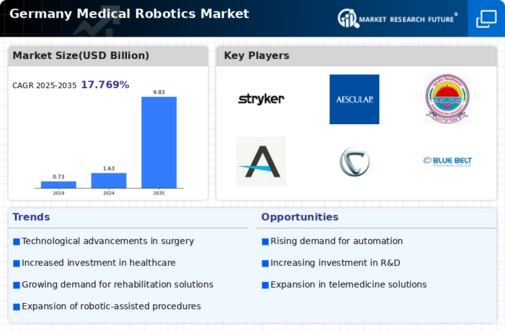Rising Healthcare Expenditure
Germany's healthcare expenditure is on the rise, which positively impacts the medical robotics market. The country allocates approximately 11.7% of its GDP to healthcare, reflecting a commitment to improving medical services. Increased funding allows hospitals to invest in advanced robotic systems that enhance surgical capabilities and patient care. Furthermore, the German government has been promoting initiatives to modernize healthcare infrastructure, which includes the adoption of robotic technologies. This financial support is likely to drive market growth, with projections indicating an increase of 10% in the adoption of medical robotics over the next few years. As healthcare facilities upgrade their technologies, the demand for robotic-assisted procedures is expected to rise significantly.
Technological Advancements in Robotics
The medical robotics market in Germany is experiencing a surge due to rapid technological advancements. Innovations in artificial intelligence, machine learning, and robotic systems are enhancing surgical precision and efficiency. For instance, robotic-assisted surgeries have shown a reduction in recovery times by up to 30%, which is appealing to both healthcare providers and patients. The integration of advanced imaging technologies with robotic systems is also improving preoperative planning and intraoperative navigation. As a result, hospitals are increasingly investing in these technologies, leading to a projected growth rate of approximately 15% annually in the medical robotics market. This trend indicates a strong commitment to adopting cutting-edge solutions that enhance patient outcomes and operational efficiency.
Collaboration Between Industry and Academia
Collaboration between industry and academia is fostering innovation in the medical robotics market. German universities and research institutions are actively partnering with robotics companies to develop new technologies and applications. These collaborations are leading to breakthroughs in robotic surgery, rehabilitation robotics, and telemedicine solutions. The influx of research funding, estimated at €500 million annually, supports the development of next-generation robotic systems. This synergy not only accelerates technological advancements but also enhances the training of healthcare professionals in robotic applications. As a result, the medical robotics market is expected to grow by approximately 11% in the coming years, driven by the continuous flow of innovative solutions emerging from these partnerships.
Focus on Patient Safety and Quality of Care
The emphasis on patient safety and quality of care is a crucial driver for the medical robotics market in Germany. Robotic systems are designed to minimize human error during surgical procedures, thereby enhancing patient safety. The precision offered by these technologies can lead to fewer complications and shorter hospital stays, which is increasingly important in the current healthcare landscape. Hospitals are prioritizing investments in robotic systems to improve their quality of care metrics, which are closely monitored by regulatory bodies. This focus on safety and quality is likely to propel the market forward, with an anticipated growth rate of 14% as healthcare providers strive to meet higher standards of patient care.
Aging Population and Increased Healthcare Needs
Germany's aging population is a significant driver for the medical robotics market. With approximately 22% of the population aged 65 and older, there is a growing demand for advanced medical solutions to address age-related health issues. Robotic systems are being utilized to perform complex surgeries that are often required by older patients, such as orthopedic and cardiac procedures. The increasing prevalence of chronic diseases among the elderly necessitates innovative surgical approaches, which robotic technologies can provide. This demographic shift is expected to contribute to a market growth of around 12% over the next five years, as healthcare providers seek to improve surgical outcomes and reduce the burden on healthcare systems.





















Leave a Comment